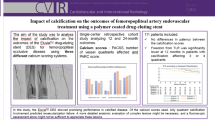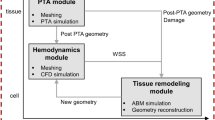Abstract
Purpose:
Comparison of the biocompatibility of self-expanding polyethylene terephthalate (PET) stents with self-expanding metallic stents (Wallstents).
Methods:
Diameter- and length-matched PET stents and Wallstents were symmetrically implanted in the paired iliac arteries of 13 crossbred domestic swine. Stent deployment was studied angiographically and with intravascular ultrasound immediately after stent implantation. The angiographic stented lumen diameter was measured using quantitative vessel analysis before, immediately after stenting, and at 6-week follow-up. Cross-section histopathology and area morphometry were performed.
Results:
Immediately poststenting, intravascular ultrasound revealed proximal dislocation of 5 of the 13 PET stents, whereas all metal stents were firmly embedded at the implantation site. At 6-week follow-up, three of the remaining PET stents were totally or subtotally occluded by organized thrombus, whereas all metal stents were patent. Compared with immediately poststenting, the angiographic lumen diameter within the five remaining PET stents was reduced by 30%, and that of the metallic stents was virtually unaltered (p<0.02). This observation was confirmed by postmortem morphometry, wherein the PET-stented vessel segments a diameter stenosis of 40% was measured vs only 9% in the metallic stents (p<0.0001).
Conclusion:
PET-stent deployment is difficult to control due to the lack of radiopacity of this stent. PET stents seem to be more thrombogenic and lead to significantly more neointimal proliferation than metallic stents.
Similar content being viewed by others
References
Bucx JJ, De Scheerder I, Beatt K, van den Brand M, Suryapranata H, de Feyter PJ, Serruys PW (1991) The importance of adequate anticoagulation to prevent early thrombosis after stenting of stenosed venous bypass grafts. Am Heart J 121(5):1389–1396
de Feyter PJ, De Scheerder I, van den Brand M, Laarman GJ, Suryapranata H, Serruys PW (1990) Emergency stenting for refractory acute coronary artery occlusion during coronary angioplasty. Am J Cardiol 66:1147–1150
De Scheerder IK, Strauss BH, de Feyter PJ, Beatt KJ, Baur LHB, Wijns W, Heyndrix GR, Suryapranata H, van den Brand M, Buis B, Serruys PW (1992) Stenting in venous bypass grafts: A new treatment modality for patients who are poor candidates for reintervention. Am Heart J 123(4):1046–1054
Strauss BH, Serruys PW, De Scheerder IK, Tijssen JGP, Bertrand ME, Puel J, Meier B, Kaufmann U, Stauffer J-C, Rickards A, Sigwart U (1991) Relative risk analysis of angiographic predictors of restenosis within the coronary Wallstent. Circulation 84:1636–1643
Burkel WE, Kahn RH (1982) Biocompatibility of prosthetic grafts. In: Stanley JH (ed): Biologic and synthetic vascular protheses. Gunn & Stratton, New York, pp 224–240
Murphy J, Schwarz R, Edwards W, Camrud A, Vlietstra R, Holmes D (1992) Percutaneous polymeric stents in porcine cornary arteries. Initial experience with polyethylene terephthalate stents. Circulation 86:1596–1604
De Scheerder I, Wilczek K, Verbeken E, Barios L, Piessens J, De Geest H (1995) Intraarterial biocompatibility of polyethylene terephthalate self-expandable stents implanted in porcine peripheral arteries. Acad Radiol 2:154–158
Van der Giessen W, Slager C, Gussenhoven E, Beusekom H, Huijts R, Schuurbiers J, Wilson R, Serruys PW, Verdouw P (1993) Mechanical features and in vivo imaging of a polymer stent. Int J Card Imaging 9:219–226
Barth K, Eicker B, Bittner U, Marhoff P (1989) The improvement of vessel quantification with image processing equipment for high resolution digital angiography. In: Lemke HV (ed). Computer-assisted radiology. Springer-Verlag, Berlin, pp 220–225
Galbraith JE, Murphy ML, Desoyza N (1981) Coronary angiogram interpretation: Interobserver variability. J Am Coll Cardiol 240:2053–2059
Fortin DF, Spero LA, Cusma JT, Santoro L, Burgess R, Bashore TM (1991) Pitfalls in the determination of absolute dimensions using angiographic catheters as calibration devices in quantitative angiography. Am J Cardiol 68:1176–1182
Author information
Authors and Affiliations
Rights and permissions
About this article
Cite this article
Wilczek, K., De Scheerder, I., Wang, K. et al. Comparison of self-expanding polyethylene terephthalate and metallic stents implanted in porcine iliac arteries. Cardiovasc Intervent Radiol 19, 176–180 (1996). https://doi.org/10.1007/BF02577615
Issue Date:
DOI: https://doi.org/10.1007/BF02577615




